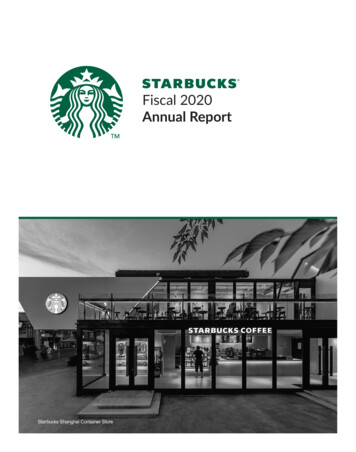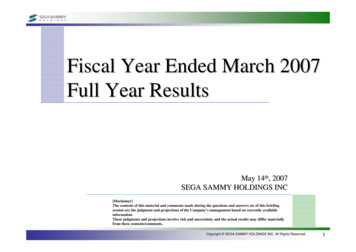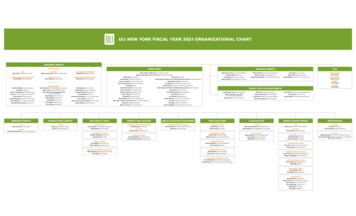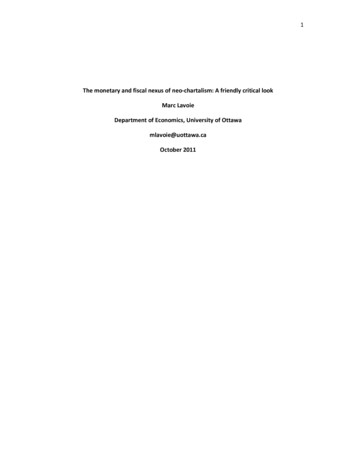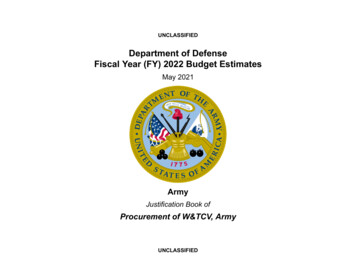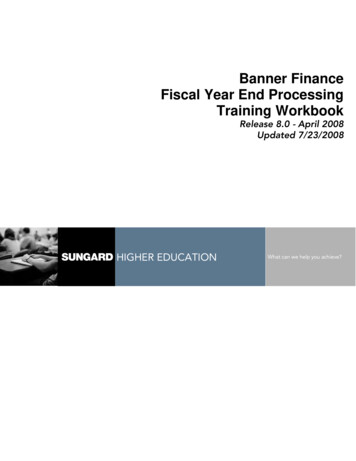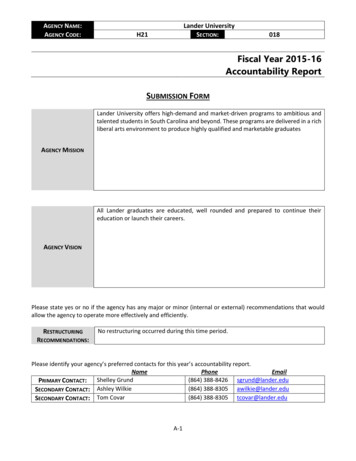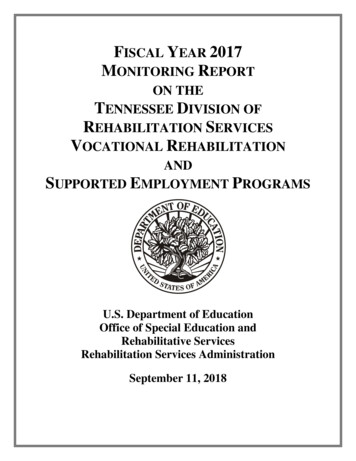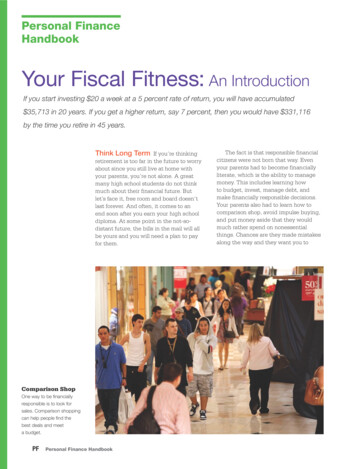
Transcription
Personal FinanceHandbookYour Fiscal Fitness: An IntroductionIf you start investing 20 a week at a 5 percent rate of return, you will have accumulated 35,713 in 20 years. If you get a higher return, say 7 percent, then you would have 331,116by the time you retire in 45 years.Think Long Term If you’re thinkingretirement is too far in the future to worryabout since you still live at home withyour parents, you’re not alone. A greatmany high school students do not thinkmuch about their financial future. Butlet’s face it, free room and board doesn’tlast forever. And often, it comes to anend soon after you earn your high schooldiploma. At some point in the not-sodistant future, the bills in the mail will allbe yours and you will need a plan to payfor them.Comparison ShopOne way to be financiallyresponsible is to look forsales. Comparison shoppingcan help people find thebest deals and meeta budget.PFPersonal Finance HandbookThe fact is that responsible financialcitizens were not born that way. Evenyour parents had to become financiallyliterate, which is the ability to managemoney. This includes learning howto budget, invest, manage debt, andmake financially responsible decisions.Your parents also had to learn how tocomparison shop, avoid impulse buying,and put money aside that they wouldmuch rather spend on nonessentialthings. Chances are they made mistakesalong the way and they want you to
Teen Spending Where Does7%8%8%All the Money Go?FoodClothing24%35%Music, Movies, and EventsAccording to a nationalsurvey, teens spend thelargest part of their moneyon food and clothing.Cars9%Cosmetics and Accessories19%9%ShoesVideo Games16%ElectronicsSOURCE: www.businessinsider.com, “Teens have a favorite new restaurant—and it’s not Starbucks,” April 2017avoid the same pitfalls. Economicprinciples you will study in this coursewill help you understand your place ineconomics and help inform your personalfinance decisions. Understand credit uses and costs. Shop wisely and know your rights as aDo a Checkup Start by taking a goodPreparing for a long race ofteninvolves delayed gratification. An athletewill sacrifice fast food because it’s badfor her health, and healthy eating willpay off in the long run. The same is trueof investing in your future. It may meanputting off purchases today for financialsecurity sometime later.That’s easy to say but hard to do,especially if you want to keep up withyour peers. You and your dollars are thetarget of marketers and advertisers.look at your own money habits. Are youa big spender? Moderate saver? Do yousave anything at all? The answer is easyto figure out. If you have an unexpectedwindfall, for example, a bigger-thanexpected birthday check or an opportunityto earn extra money, what would you dowith that money? Save it all? Save half?Look to see what you can buy now?Think Discipline It comes downto fiscal fitness. Developing a solid,fiscal muscle also involves trainingor budgeting, short- and long-termgoal setting, and most of all, patience.Personal finance, like athletics, requiresdiscipline and practice. Discipline is oneof the qualities that defines a winner. Ifyou want to come out on top, learn therules of good financial citizenship andput them into action: Keep a budget in order to live withinyour means.consumer. Develop short- and long-term financialgoals.The Long Race The challenge isthat the impulse to get what we wantnow is far stronger than the motivationto save for something that is months oreven years down the road. You may haveto inspire yourself to save by promisingyourself a reward when you have metcertain goals.What else could slow down yourprogress? One speed bump for manyis credit card abuse. You don’t want tostruggle to pay your credit card balanceYour Fiscal Fitness: An IntroductionPF 1
Personal FinanceHandbookWeekly Savings Start SavingStarting a savings planearly in life can result ina substantial amount ofmoney at retirement age.This table shows how muchmoney a saver will haveat the age of 65 (with anannual rate of return of8 percent) if he or she savescertain amounts eachweek and starts saving ata certain age.AGE 10 25 50 10020 228,563 571,408 1,142,817 3879,277SOURCE: www.osu-tulsa.okstate.edu/financialaid, Savings Growth Chart TIPSave asmuch aspossible!Saveconsistentlythroughoutyour life. Youcan use yoursavings to makelarge purchasesand avoidaccumulatingdebt.in full each month or miss payment duedates. Therefore, it is important to keepan eye on your bank balance to makesure you can afford to buy what youneed or want. It’s also important to checkyour credit card statements and read thefine print about bank fees and interestrates. Often, missing a payment due dateresults in extra fees and higher interestrates. Developing this fiscal awarenessnow will keep you out of trouble later. Asyou study economics, the principles youlearn will help guide you to build yourfinancial future.Grow Your Money Despitethe difficulty of thinking long term,65 percent of teens admit that they wantto learn how to grow their money. Thisis good news. Even better news is that84 percent of teens have savings, with anaverage amount of 1,044.Savings could translate into a car andcollege expenses in the short run and asecure life and retirement in the yearsto come. In no time at all, the followingwords will be part of your vocabulary:budgeting—how to spend your incomein such a way that there’s somethingleft over to invest; compounding—howsaving a little now can translate intomore money later in life; and investing—how putting money in the stock marketcan be a tool for saving. Over the last50 years or more, the stock market hasaveraged a higher return rate than bankaccounts or bonds. Ready, set, grow!It’s Your Turn1. Why is it important to start thinking about budgeting andsaving now?PF 2Personal Finance Handbook
BudgetingDo you keep track of how you spend your money so that you will haveenough to meet your needs? If so, you have already met one of thefundamentals of personal finance: budgeting.Budgeting 101 A budget is a planfor spending and saving. The word mayconjure up images of driving a junk caror eating canned spaghetti every night,but the reality can be just the opposite.In fact, most millionaires use a budget tomanage their money. And most of themstarted early.any idea how you would answer them,then maybe it’s time to think aboutmaking a budget. How much money did you spend onbeverages—from soda to water toenergy drinks—last week? How much money will you spend ongas next week? How long will it take you to save up forSpending Awareness Surveysshow that almost one-half of Americansbetween the ages of 13 and 18 know howto budget their money. That’s the goodnews. The bad news is more than half ofAmericans do not.You can become more aware of yourpersonal spending habits by takingthis quick quiz to find out which groupyou fall into. If you can answer thesequestions without much trouble, you’vealready taken the first steps to goodmoney management. If you don’t havethe expensive thing you’d like to buy?Now here’s another question. Haveyou ever asked for money to spend onconcert tickets, a piece of jewelry, or aski trip, only to hear: “You don’t need it,and we can’t afford it”? Odds are youdidn’t think of it as an economics lesson.But according to surveys, students wholearned about money management athome scored higher on financial literacyassessments than those who learnedabout it only in school.Average American Family Budget5%3%3%2%HousingTransportationFood5%Insurance and Pensions33%8%HealthcareOtherEntertainment11%13%17% Why PersonalBudgets VaryBudgets will vary basedon lifestyle and income.Developing a budgetthat includes all of thecategories of spending willhelp determine how muchmoney to set aside for eachcategory.ApparelCash ContributionsEducationSOURCE: Bureau of Labor Statistics, Consumer Expenditures, 2015BudgetingPF 3
Personal FinanceHandbook TIPLearn fromothers.Find amentor whoconsistentlymakes a budgetand sticks to it.Observe howlittle stresshe or she hasabout moneymatters.Income and Expenses Eachperson has an economic identity. Yourincome—the money you make—andyour expenses—the money you spend—define that identity. Therefore, you willface money scarcity. Budgeting is thebalancing act to deal with this scarcity.Effective budgeting will help you controlyour expenses so that they do not exceedyour income. As you develop your budget,you will weigh your needs against yourwants. To begin creating a budget, followthese steps in order. Make a list of your earnings per monthfrom all sources. Add these togetherto calculate your expected monthlyincome. For one month, keep a record of everything you spend, from chewing gum tocar payments. Collect receipts, writeeverything in a notebook, or better yet,use a budgeting tool online or an appof your choice. Make sure you don’tleave anything out. (And that includessavings!) At the end of the month, organize yourspending into categories such as food,entertainment, and car payments.Total the amount in each category.If you are using an app, you will becategorizing as you go. On a sheet of paper or using your app,list your income and expenses.If your total expenses are less thanyour total income, you’re doing fine.If not, you need to take a hard look atwhere your money is going.Needs and Wants Right now, manyof your basic needs are probably part ofthe household budget. Still, some of yourpersonal funds may be going towardneeds such as car insurance, lunches, orcollege savings. So, if you are looking tocut down on expenses, you should focusfirst on the wants.Consider the example of Michelle,a high school senior. She works 20hours a week at a department store,where she earns 10 an hour. Her netincome—that is, her take-home pay aftertaxes—is 150. Her monthly necessitiesinclude 40 for her cell phone bill, 60on average for gas, and 65 a month onBudget Boosters Be BudgetRecord spendingKeep a spending journal for one week. Include every latte,vending-machine snack, and music download.to stay on track with yourspending and saving.Identify needsIdentify needs: bills, car payment, and so on.Spend wiselyDownsize or eliminate impulse buys such as coffee and soda.Prioritize savingMake saving a priority and a habit.Save weeklyAdd to your savings weekly, even if just a small amount.Plan for thelong-termIdentify a long-term want and start saving for it. (You’ll besurprised how fast those fast-food outings diminish when youset your mind on something.)Pay down debtPrioritize and pay down any outstanding debt—including that 5 you owe your sister.Use cashUse cash for daily spending.Work moreDuring vacations or the summer, pick up some extra hoursat work.Spend lessLive within your means. Spend less than you make.Smart Follow these tipsPF 4Personal Finance Handbook
Rewards ofPlanning You canachieve financial goals,such as renting a limousinefor prom with your friends,when you make a plan andstick to it.car insurance. Michelle has already setaside 300 for her prom and hopes tohave 500 by the time prom rolls around.To stay within her budget, she gives upher daily soda habit, saving almost 30 amonth. She and her friends also decideto watch movies at home rather than goout. This trade-off will allow them to renta limousine to go to their prom. Michellehas planned for a long-term goal andbudgeted correctly. She has drawn a fineline between needs and wants.If you find you’re having a difficult timestaying within your budget, ask a friend orfamily member to review your expenditureseach week to help keep you on track. Trynot to rationalize impulse buys. Considerthem your sworn budget enemies.Long‐Term Rewards Err on theside of thrift and responsibility. Livewithin your means and try to save a setpercentage of your income. Some budgetcounselors suggest allotting 80 percentfor needs, 10 percent for wants, and 10percent for savings. Do that and youmight find yourself with a tidy savingswithin a few short years. Spend withouta plan and you might end up like manyAmericans—deep in debt.About 607 billion, or 4.8 percent ofoutstanding debt, is in some stage ofdelinquency, or late in payment, with 412 billion 90 days late in payment.The 90-day delinquency rate on creditcard balances was 7.1 percent of thetotal credit card debt in 2016, while11.2 percent of student loans in 2016were in 90-day delinquency or indefault. Learning how to budget nowmay spare you from being part of thesegrim statistics later.It’s Your Turn2. Using the information your teacher supplies you, develop amonthly budget for a typical high school student. Notice thatseveral of the expenses are fixed amounts. You can decide toincrease, decrease, or eliminate other expenses, but be realistic.Now think of something this particular student would like tobuy, or spend money on, in six months. Build that goal into thebudget. How much does he or she already have saved towardthat goal? How much more does he or she need to save? Whattrade-offs might he or she be willing to make to reach that goal?BudgetingPF 5
Personal FinanceHandbookBanking and CheckingBanks are everywhere. Often they face each other at busy intersections in a community andare even sometimes located in the front sections of supermarkets. These banks, as well asother financial institutions, are vying for your business. How do you choose among them?The Right Bank You want to choosea bank that is insured by the FederalDeposit Insurance Corporation(FDIC). The FDIC protects your moneyand the interest that it has earned—upto the insurance limit—in the event thatyour bank fails. For an account held by asingle individual, the FDIC-insured limitis 250,000.Though banks are generallyconsidered to be financially sound,failures do occur. The insurance pro
your credit card statements and read the fine print about bank fees and interest rates. Often, missing a payment due date results in extra fees and higher interest rates. Developing this fiscal awareness now will keep you out of trouble later. As you study economics, the principles you learn will help guide you to build your financial future. Grow Your Money Despite the difficulty of thinking .

